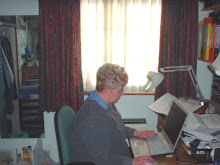Unfortunately not everyone recorded in Toronto’s census of 1861 will be present in my transcription. I have named them my Invisible People.
Every once in a while I come across a census form which might as well be a blank. Usually this is because of the technology of camera and film in the 1950s when the microfilms were prepared.
We have become very used to the principles of digital cameras. We can point and shoot and then immediately inspect the photograph. We have forgotten the routine of only 10 or 15 years ago when we snapped 12, 24 or 36 pictures and then took the reel to the drugstore and waited an hour or a day or a week for film to be transformed into photographs. We collected them and immediately began to wish we hadn’t taken some of them. We hadn’t noticed the movement or the potential over- or under-exposure.
The same thing happened at Library and Archives Canada when they decided to condense an archive by putting the 19th century censuses on microfilm. The old census pages were clamped on a flat surface and the pictures taken from a camera perched overhead, probably fixed in a small gantry. In each of Toronto’s wards over 2000 photographs (two for each form) were required. Some people wrote in pencil, some wrote with thick pen nibs, some changed their minds and scratched out their original answers, some had their answers changed for them by enumerators. If a householder decided to give their family’s names as surname and initial, the enumerator went back and asked for clarification. The given names ended up in the margin where they often ended up under the clamp holding the fraying paper edges in place.
A basic exposure setting was needed. It could not be easily altered to cope with the differences in the individual pages. The film crew could only foresee a few of these problems as they took the pictures. And, after the images making up the film were processed, it really wasn’t worth going back for an extra shot here and an extra shot there. It would have taken the patience of Job to match up the poor quality images with the originals and retake them and then interleave them into the right places. Ever wondered why it costs Hollywood more than a million dollars to make a movie? Careful editing was definitely not a job to consider doing in a minor government department!
Hence the quality of the images on the microfilm I have looked at. The choice of focus must have leaned toward darker images. Did they have an exposure meter? Would it have worked given with so few shades of grey? I am not a professional photographer and I don’t know the answer to these questions. All I know is that when a census schedule written in pencil was overwritten in places by an enumerator, the corrections appear on the film but the original names do not. And the names, over to the left hand side of the form, are less likely to show up than the ages and genders closer to the centre.
If anyone reading this participated in the census microfilming way back in the 1950s I would love to know how close my theorizing comes to the actual process.
Thursday, 12 March 2009
Subscribe to:
Post Comments (Atom)




No comments:
Post a Comment